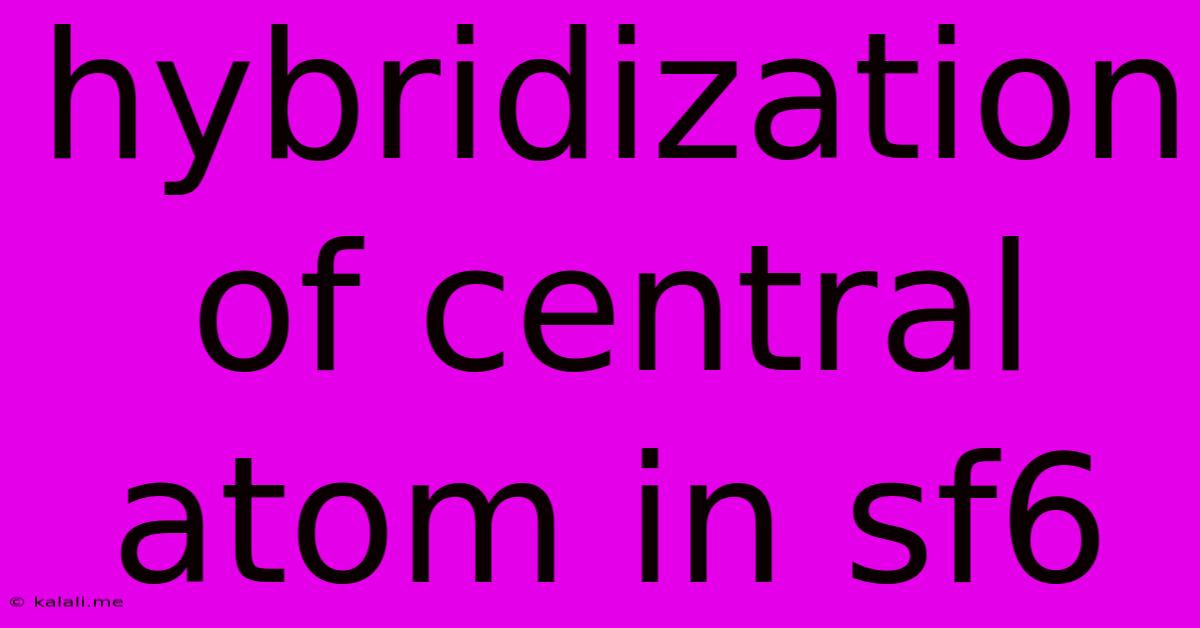Hybridization Of Central Atom In Sf6
Kalali
Jun 14, 2025 · 3 min read

Table of Contents
Hybridization of the Central Atom in SF₆: A Deep Dive
Meta Description: Understanding the hybridization of sulfur in sulfur hexafluoride (SF₆) requires exploring its molecular geometry, electron configuration, and the concept of hybrid orbitals. This article provides a comprehensive explanation, perfect for chemistry students and enthusiasts.
Sulfur hexafluoride (SF₆) is a fascinating molecule that challenges our initial understanding of valence shell electron pair repulsion (VSEPR) theory. Its seemingly impossible structure, with six fluorine atoms surrounding a single sulfur atom, necessitates a deeper look into the concept of hybridization to fully comprehend its bonding. This article will delve into the hybridization of the central sulfur atom in SF₆, explaining the process in a clear and accessible manner.
Understanding VSEPR Theory and its Limitations
Before diving into the hybridization of SF₆, it's crucial to understand the basics of VSEPR theory. This theory predicts the three-dimensional arrangement of atoms in a molecule based on the repulsion between electron pairs in the valence shell of the central atom. While VSEPR is remarkably accurate for many molecules, it falls short when predicting the structure of some hypervalent compounds like SF₆. In these cases, the concept of hybridization becomes essential.
The seemingly simple application of VSEPR to a molecule like SF₆ would predict only four electron pairs (due to sulfur's six valence electrons), leading to a tetrahedral or square planar geometry, far from the observed octahedral structure. This discrepancy highlights the need for a more sophisticated model incorporating hybrid orbitals.
Exploring the Electron Configuration of Sulfur
Sulfur (S) has an atomic number of 16, with an electron configuration of [Ne] 3s²3p⁴. In its ground state, sulfur has only two unpaired electrons in the 3p orbitals, which would seem to only allow for the formation of two covalent bonds. However, to form six bonds with six fluorine atoms, sulfur needs six unpaired electrons. This is where hybridization comes into play.
The Role of Hybridization in SF₆
To accommodate six fluorine atoms, the sulfur atom undergoes sp³d² hybridization. This process involves the mixing of one 3s orbital, three 3p orbitals, and two 3d orbitals to create six equivalent hybrid orbitals, each with one unpaired electron. These hybrid orbitals are then used to form six sigma (σ) bonds with the six fluorine atoms.
- The process: The 3s and 3p orbitals of sulfur combine with two empty 3d orbitals. This results in six sp³d² hybrid orbitals oriented at 90 degrees to one another, creating the observed octahedral geometry.
- Octahedral geometry: The six sp³d² hybrid orbitals arrange themselves in a way that maximizes distance between them, leading to an octahedral geometry where the six fluorine atoms are located at the corners of an octahedron.
- Bonding: Each of the six sp³d² hybrid orbitals forms a sigma bond with a fluorine atom through the overlap of the hybrid orbital and a fluorine 2p orbital.
The energy required to promote electrons to higher energy levels and participate in hybridization is offset by the energy released during the formation of six strong S-F bonds. This energy balance makes the octahedral structure of SF₆ stable.
Conclusion
The hybridization of the central sulfur atom in SF₆ is a key factor in understanding its structure and stability. The sp³d² hybridization allows sulfur to form six sigma bonds with six fluorine atoms, resulting in the observed octahedral geometry. This example beautifully illustrates the limitations of VSEPR theory alone and the importance of hybridization in explaining the bonding in hypervalent molecules. Understanding this principle is crucial for comprehending the complex world of chemical bonding and molecular geometry.
Latest Posts
Latest Posts
-
Which Of The Following Describes A System
Jun 14, 2025
-
Strategic Human Resource Management Exam Questions And Answers
Jun 14, 2025
-
What Is The Least Common Factor Of 36 And 45
Jun 14, 2025
-
What Is The Prime Factorization For 58
Jun 14, 2025
-
University Of Washington Average Sat Score
Jun 14, 2025
Related Post
Thank you for visiting our website which covers about Hybridization Of Central Atom In Sf6 . We hope the information provided has been useful to you. Feel free to contact us if you have any questions or need further assistance. See you next time and don't miss to bookmark.